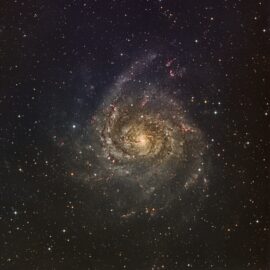M100 Area of Coma Berenices
Planewave CDK 12.5in; AP 1100GTO AE; QHY600M, – Antlia Broadband and 3.5nm Ha Filters
L: (43 x 180s, Bin 1, Gain 100); H: (26 x 720s Bin 1, Gain 100); R,G,B: (22,29,30 x 210s, Bin 1, Gain 100)
Total integration time = 12.1 hrs (Apr 22-24, 2025) Cowichan Valley, BC, Canada
For full resolution, downloadable images please link to the Victoria RASC Zenfolio gallery or Astrobin gallery.

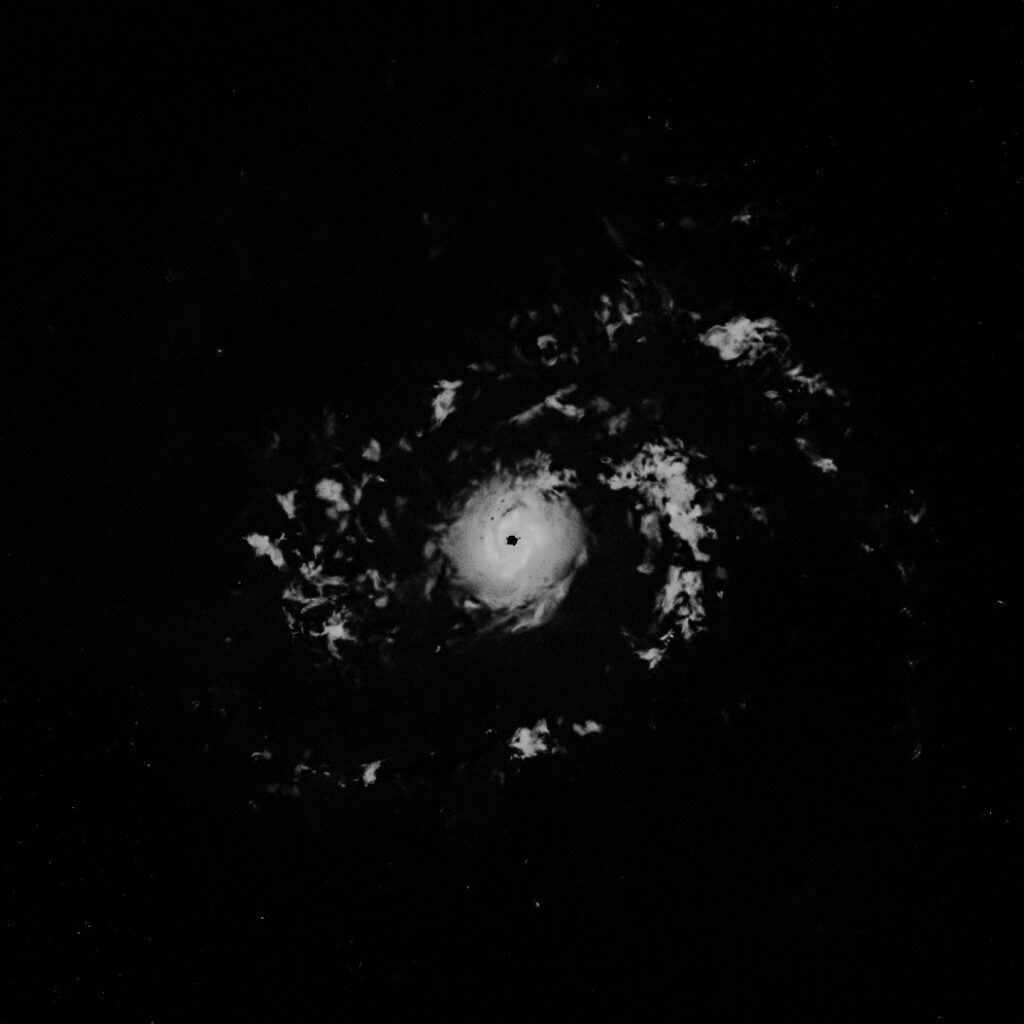
Facts on M100 (Messier 100)
M100, is a huge grand design spiral galaxy lying in Coma Berenices and is part of the massive Virgo cluster. It’s visible diameter (in the image) is 165,000 ly (roughtly twice the visible diameter of the Milky Way, but its true diameter is likely many multiples of this when you consider the invisible extensions of the monatomic and diatomic hydrogen arms.
Unlike the Milky way, which is a barred spiral (having a “bar” or stars and material at its centre), M100 is a considered an “intermediate” galaxy – much like Caldwell 5 shown in a previous image. In this context intermediate means, if it has a bar it is either too small to see or is in the process of forming.
M100 is also considered a starburst galaxy, due to the high rate of star formation taking place. In particular, there is a lot of star formation taking place right at its core, as evidenced by the strong Halpha signal bands near the centre of the visible spiral. Halpha emissions occur in hydrogen atoms recovering from UV bombardment from new stars and represent one of the few conditions that allow us to see gaseous hydrogen directly. The emissions create the red blotches we in our visible light galactic images.
Most images of galaxies are much brighter near their core than M100, with this Ha signal being overwhelmed by the stars that are created there. It should be noted, that the spiral arms near the core are at a much finer scale than further out and this results in trend of smaller, but longer lived stars here. Nonetheless, there are lots of Halpha indications that stars are also being created further out in the arms as well.
Arms vs Gaps : Molecular Clouds vs ISM
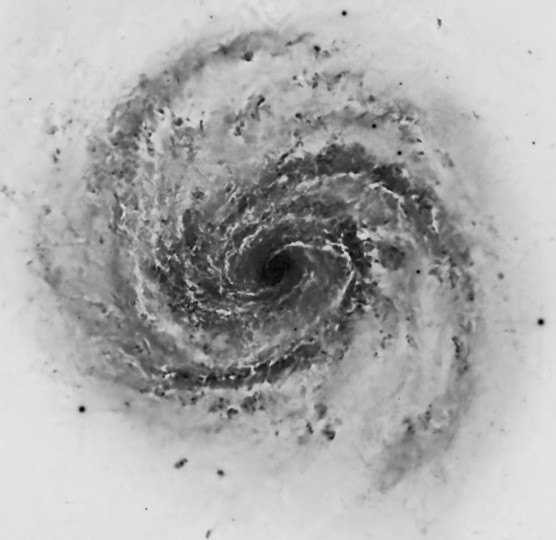
In the posting series on the Spiral Galactic Structure, I showed how the dynamic skeleton of the a spiral galaxy was formed by two phase-states of hydrogen, orbiting a central black-hole. The treatment of diatomic hydrogen molecules as a real gas with thermodynamic consequences meant that thermodynamic and fluid mechanics would both influence the structure, and explain why the spiral arms exist, and why the spiral shape orbits at a constant period (the winding problem).
The behavior of a spiral galaxy is best described as chaotic, and exhibits the characteristics of non-linear dynamics. But there is order out of chaos, and in the case of a spiral galaxy, this results in the the spiral pattern we see. What a still camera doesn’t capture, however, is that the whole galaxy structure rotates around its centre with a constant angular velocity or time period, no matter the radius, or distance from the galactic centre.
The turbulent Reynolds number meant that the most stable configuration of hydrogen in a rotating disc galaxy was as a denser (relatively speaking : 2E-15 to 2E-14 kmol/m3) diatomic, molecular cloud within the spiral arms with extremely rarefied (100 to 300 atoms/cm3 or 2 to 5E-19 kmol/m3) hydrogen atoms (interstellar medium, ISM) separating the spiral arms. The spiral structure, in effect, is nature’s way of avoiding dissipation of energy by confining, as turbulent flow, as much as possible to the low viscosity (drag coefficient) ISM.
The spiral arms and molecular clouds in a galaxy are remarkably robust with their conformance held together by viscous drag, self gravity, Bernoulli effects, and angular momentum. Not only do the arms hold together in the galaxy,
but also under conditions of major disruptions such as the tidal effects of nearby galaxies and even galactic mergers. However, without the support of the galactic structure and fluid mechanics effects, pressure dispersion will cause them to slowly and eventually dissipate into the void. Within the galaxy the molecular clouds are largely self healing and can take the disruptions offered by stellar migrations, stellar nurseries, or even supernova explosions. In addition, the spiral arms often extend well beyond the part of the galaxy we can see and photograph – without stars and dust to highlight their presence. Occasionaly they will bifurcate or merge with two arms becoming one or one becoming two – exposing their chaotic origin.
Of course, the molecular cloud arms wouldn’t be arms without the gaps between them, and this is composed largely of hydrogen too, but in a monatomic form. The gap ISM isn’t just responsible for separating the spiral arms, but also for their integrity of the arms themselves. Together, the molecular cloud arms, and the ISM gaps form the circulatory system of the galaxy. Hydrogen, stars, and dust all periodically travel between the arms and gaps even though this is not entirely obvious from our static galactic images.
One of the results of consequence of our galactic model, is a periodic nature of the g-force acting on a mass the was strongest (most negative – towards the galactic centre) i n the spiral arms, but reached local maxima (weaker) within the ISM between the arms as indicated on the figure at right.
One of the conseqences of this model is an explanation for the curious, periodic, and seemingly gravity defying orbits displayed by both stars and atomic hydrogen atoms as they orbit. While we can’t actually see atomic hydrogen with our eyes, astrophysicists can detect the ultrafine band IR photon (21 cm) emissions cause by a spin flip of its electron. We can also gain knowledge of its velocity from its red-shift.
The periodicity of gravity is a direct result of the periodicity of the molecular cloud arms. While gravitational pull, as measured by it g force (acceleration) , gets stronger (more negative) as distance from the centre of the galaxy, it reaches it locally strongest point (valleys in the plot at right) at the outside edges of the spiral arms, while it is at its weakest on the inner edges. This is a result of the spiral alternatively enhancing and diminishing the overall gravitational pull towards the centre.
In this way, any particle travelling through the galactic structure, either in the radial or angular directions or any direction whatsoever, will experience an ebb and flow of gravity.
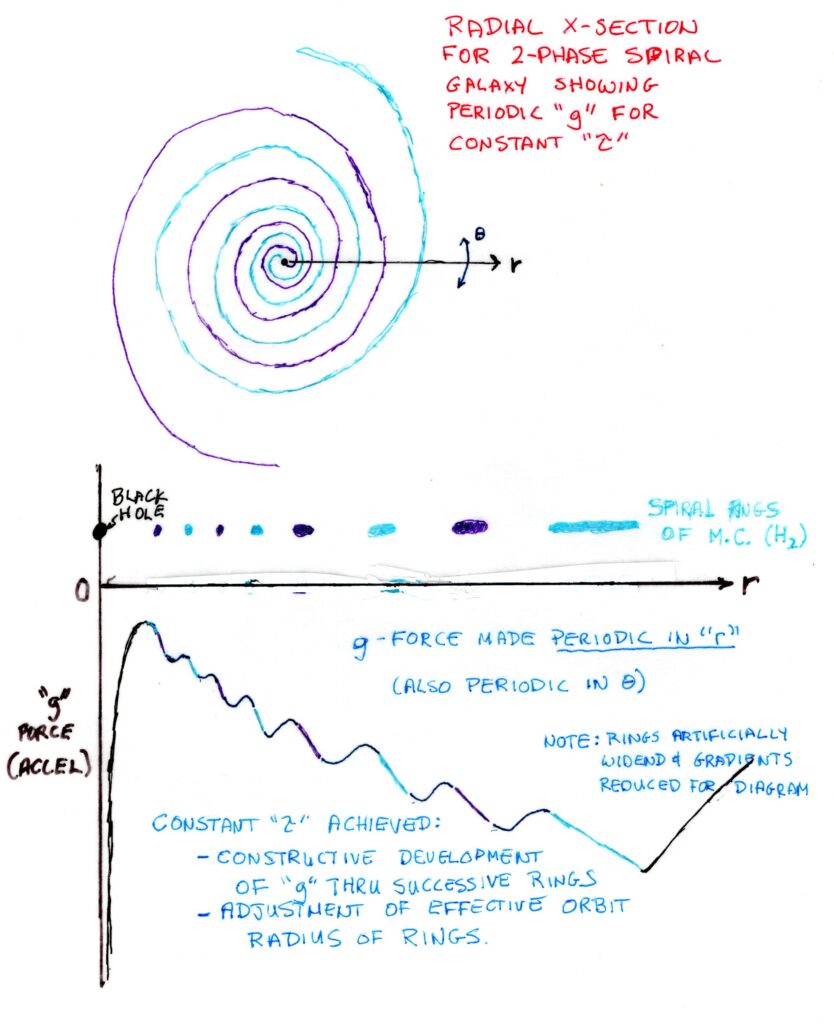
Gravity vs Inertial Forces (aka angular momentum) in a Spiral Geometry
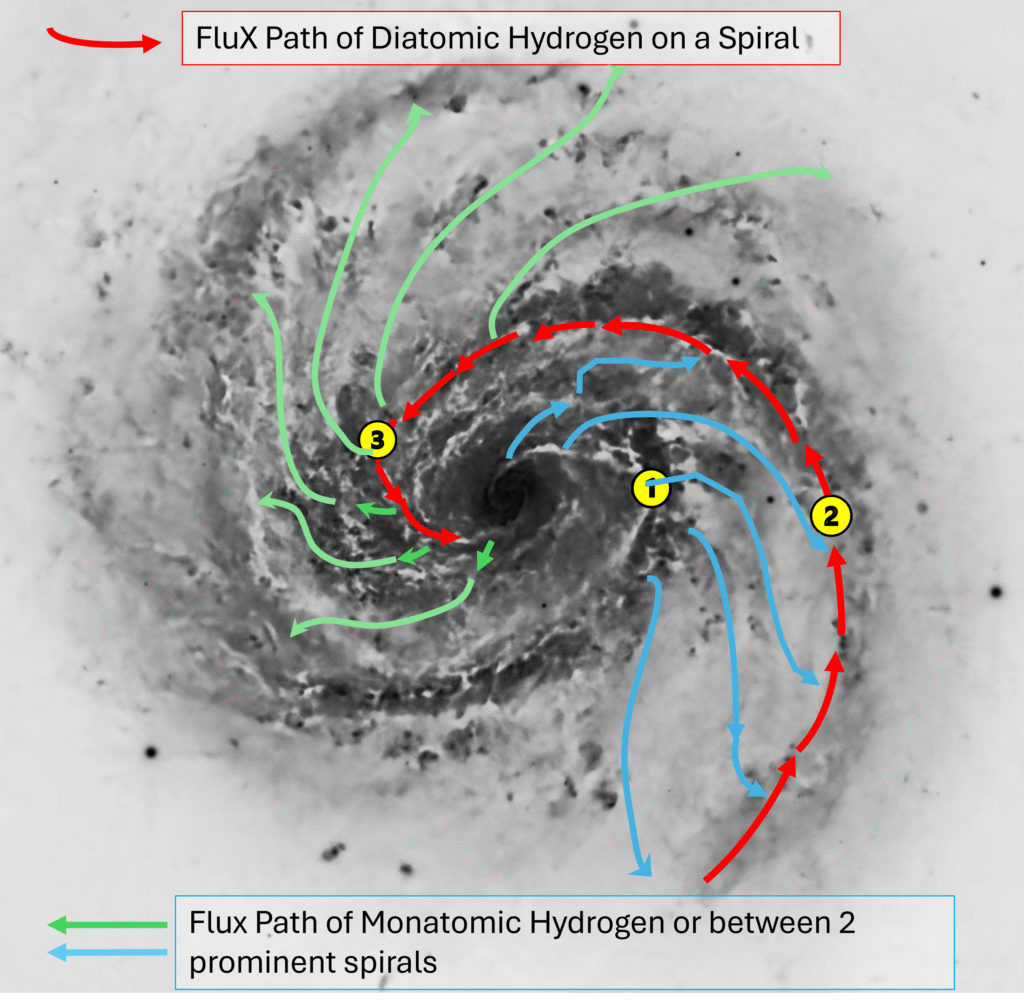
When viewing images of spiral galaxies, it is easy to forget that the whole system is rotating about the centre, generally at a constant angular velocity (constant period) regardless of the radial position. Just like a centrifugal pump, galaxies rotate in the direction of of their convex side. Thus the M100 galaxy is rotating counterclockwise – at least from our side of the galaxy. We have to remember that essentially all of the galaxies components have a certain amount of angular momentum in this direction.
Usually when analyzing a structure, we try and pick a reference frame that simplifies our force and flow equations and avoid the use of tensors. (I have place here an excellent youtube link in about tensors by FloatHeadPhysics by Mahesh Shenoy, who is one of my favourite physics explainers who I highly recommend you visit, since you are obviously interested in physics.)
For our galaxy we will chose a polar coordinate frame of reference that is rotating about the centre/origin of the galaxy at the same constant period as the galactic arms. If the galaxy were simply a disc or rings (angularly homogeneous), describing the forces at work: gravity, conservation of angular momentum would also be very simple. Centrifugal force would balance gravitational pull, and this equal but opposite balance would determine both a component particle’s position and trajectory. Both centrifugal and gravitational forces would originate or terminate at the origin and discussed as scalars rather than tensors.
Unfortunately in this spiral shape, the components don’t orbit the centre/origin. Both the radius of curvature and the entre focus of their orbit depends on where they are. Both forces and flow streamlines follow curves. For these reasons, I have drawn (figure at left) in several flow lines that would be taken by hydrogen as it move both along the spiral arms and through the gaps between spirals.
Hydrogen, in the molecular cloud phase tends to move at a relatively leisurely pace around the direction of the spiral towards the centre. At any point, the pull of gravity is largely tangent to the spiral and somewhat larger that the centrifugal force allowing the molecule to accelerate in this direction. Due to drag effects, flow around the spiral is done in a bulk fashion and the molecule’s angular velocity is faster than that of the galactic structure. In the spiral, gravity beats out centrifugal forces. Within the gaps, where gravity is reduced, centrifugal forces dominate and hydrogen, mainly in monatomic form take an radial outward path, where the angular velocity is reduced. Unlike the spiral arms, there is little drag force or conformance to the hydrogen atoms – in this region the particles move much more rapidly and at the same time turbulence occurs almost unfettered. There is little energy loss due to the lack of viscosity or viscous drag.
In our rotating frame of reference, the movement of hydrogen is countercurrent (opposite in the opposite direction) both radially and angularly, within the arms and the gaps. The galaxy as a whole doesn’t shrink and expand as the outward flux with the gaps equals the inward flux along the spiral arms. In order to make the mass fluxes balance, velocities in the gaps is much higher than in the much more dense, inward flowing, spirals.
Dr Heckle and Mr Hydrogen
With one king of hydrogen (molecular cloud) moving towards the galactic centre along the arms, and another (monatomic ISM) moving outward, you may think that eventually the supply of these two ingredients would run out. Luckily this does not happen, because at the interface of the arms and the gaps, one form of hydrogen can be converted two another according to the the simple reversible equation 2H = H2, normally called the association/disassociation reaction. At standard conditions, atomic hydrogen rapidly becomes H2 and essentially 100% of atomic hydrogen will convert to molecular hydrogen. At galactic pressures and temperatures, however, there is a balance in the equation, with the balance favouring H2 molecules in the molecular cloud, and favouring atom hydrogen at the even lower pressures within the ISM.
We are used to saying that enthalpy, or internal energy drives the spontaneity of chemical reactions, but the truth is that changes in entropy are also a consideration via the Gibbs Free Energy that determine the direction of the reaction. At the higher pressure of the molecular clouds, less work needs to be done on the molecules to get them to come together, so the Gibbs free energy favours the low enthalpy of molecular hydrogen. In the ultra low pressure, the entropy gain drives the dissociation of the hydrogen atoms. I will drop this thermodynamics lesson in a moment, but if you happen to hear that a reaction stops at a certain point because the next step is endothermic, (such as nuclear fusion to iron), you may realize that the reaction can be taken further (such as fusion to gold), if the entropy gains outweigh the energy requirements (such as occurs in a supernova). Le Chatelier’s principle, also predicts that as density and pressure approach essentially nil in the spiral gaps dissociation of hydrogen provides two atoms from one molecule to help fill the void.
Whether the hydrogen exists as diatomic molecules or as atoms greatly influence the properties of the galactic gas. For our current purposes, the most important property is viscosity, or flow drag coefficient. As a molecule, hydrogen has a significant viscosity that drives the multiphase/multistate structure of the galaxy. Monatomic hydrogen has comparatively extremely small viscosity that allows for turbulence in the ISM, without large energy dissipation. The viscosity is hydrogen molecules ends up being vitally important to other critical processing in space. For example, it is critical for the accumulation of hydrogen on a protostar – without viscosity to dissipate angular momentum (and turn it into heat) – hydrogen would simply orbit the protostar. Stars are made of molecular hydrogen and not hydrogen atoms – but more on this in another post.
The other major property difference is in regard to the 21 cm IR emission line that is used to track and clock the speed of hydrogen atom. This has little impact on the galactic structure, but it sure hurts our ability to detect or track where the hydrogen is. Hydrogen molecules dont emit detectable IR at the low temperatures found in the galaxy – the 21 cm line is absent. The only astrophysical detection of hydrogen molecules can be done is in warmer spots in the galaxy such as within Herbig Haro jets or protoplanetary discs.
Connecting the Dots
We are going to assume for a moment, that we have the magical ability to track a single atom as it traverses M100 following the dots 1,2,3, shown in our inverted image of the galaxy. It isn’t meant to be a “typical path”, just a path to illustrate the concepts presented here. Of course, a lot of interesting things could possibly happen to such an atom on its journey- such as become part of a star, swept up by a supernova, or many other things, but we are going to stick to a plain path.
At point 1 on the image, Duety (I whimsically called our atom Duety after the tracer isotope, but I don’t want to give him special inertial properties) is near the outer edge of a spiral arm, covalently bonded to a partner in a molecule. When Duety and his partner get too close to the edge of the spiral, turbulence starts to make his progression along the spiral path a little shaky. This turbulence causes everything from sections of molecular cloud through erosion to individual molecules via local strong pressure gradient to leave the main arm of the galaxy. These sections of molecular cloud are torn away into the spiral gaps and then find that they are eroded on all sides by the fast moving ISM (see image below). Eventually the molecules find themselves alone, in the regions of extremely sparsely populated ISM gap (low pressure).
Following Le Chatelier, and finding that life would be better alone, at least as far as free energy is concerned, the Deuty and his molecular partner decide to dissociate to help fill the void / vaccuum. At the same time, a now independent Deuty feels the tug of gravity of the spiral arm ease, and as a result centrifugal force starts to win the tug of war. In essence Deuty, after leaving the spiral arm, performs a U-turn and now moves to reduce both its angular momentum by increasing its distance (radius) from the spiral’s orbital centre. This compounds upon itself – as Deuty moves further from Point 1 gravity from his convex (to him) spiral arm gets weaker and weaker and Deuty accelerates more. It would be a mistake to say he flows alone with the ISM, because these hydrogen atoms are not at all organized into a steady stream, there is almost no viscous drag to homogenize their speed or direction or provide any uniformity or cohesion.
Moving along the ISM path increasing both his orbit radius and and decreasing his angular velocity, Duety starts to feel the tug of the concave side of the next arm out. Since Duety has lost its angular velocity (rate of change of azimuth) this new spiral arm is also moving towards Duety. This outward tugs doesn’t completely cancel out the gravity from the galactic centre, but it diminishes it a lot. Duety likely turns somewhat towards this new spiral arm and moves towards it. There is a lot of turbulence at the edge of this arm too, but most of the eroded material on the concave side will eventually find itself pulled back into the same arm. In our case, Duety slams into the spiral arm at point 2.
When Duety enters this arm that is “farther out”, he immediately finds himself in the relatively crowded (10 to 50 thousand times as crowded) molecular cloud again. The pressure of this crowd finds Duety desparate to make some space available, quickly finding another partner to become a molecule again. Even as a molecule, Duety and his partner find themselves mobbed by other molecules and Duety is forced by this viscous drag to reverse his trajectory once again to join overall flow of the mob. Even gravity seems to suddenly change direction and magnitude and overcome centrifugal force, but the progression is much slower than he experienced in the spiral gap. Rather then perpendicular to the spiral arm, the main force of gravity is longitudinal along the spiral arm.
It may take an extreme amount of time, but eventually Duety and his partner (he may have changed partners many times along the way), reaches Point 3, again towards the convex outside edge of his spiral arms – again to be potentially eroded away into the ISM. If Deuty could see, he might look outwards, across the ISM, at the concave side of the next spiral arm out, not realizing that this was the same spiral arm where the journey started.
The Importance of Good Circulation
Helium and dust are necessary for star creation, and at the same time are waste products of stars left behind when they die. The dust in particular needs to be distributed throughout the galaxy for additional star creation. At the same time, fresh hydrogen needs to be brought in as the “solution to helium pollution is dilution”. With somewhat different paths due to different transport mechanisms the different components travel somewhat different paths, resulting in a distribution of everything – as if the galaxy was a giant mixer.
Stars themselves take a very different path than hydrogen atoms or molecules. If only gravity and angular momentum (both of which are linear with mass) were at play their paths would be nearly identical. However, with their huge effective diameters, viscous forces play almost no role in the path of stars. Stars are able to plow right through the spiral arms while at the same time, subject to the same gravitational forces and angular momentum as the tiniest of molecules.
Ultimately, stars become the downfall of the circulatory system, as the hydrogen media gets constantly interrupted by the passage of stars, and too polluted with products. Too many stars will result in their own gravitational footprint overwhelming that of the hydrogen itself. The result, upon the deterioration or destruction of the spiral arms and without a fresh supply, will be the transformation of a spiral galaxy into an elliptical one.
LBN 534 – The Erosion of a Molecular Cloud by ISM wind
Askar 151phq (FIRST LIGHT!); AP Mach2 GTO; ASI6200MM, – Baader RGB & 6.5nm NB CMOS opt. filters
Ha: ( 74 x 600s, Bin 1, Gain 200); R,G,B: (59,64,65 x 100s Bin 1, Gain 200); L: (83 x 240s, Gain 100)
Total integration time = 23.1 hrs
LBN 534 is the catalogue name of a checkmark shaped molecular dust cloud in Andromeda that contains a lot of interesting features. Firstly, one can see that it actually lies in a larger environment of wispy dust. A few bright stars, embedded in the check are producing blue reflections off it, provided a nice contrast to the otherwise reddish brown / grey dust colour reflecting the glow of the milky way. The main body of this dark nebula is a molecular cloud that is being eroded by ISM wind.
There are at least a dozen background galaxies in this image too, some of which can be readily picked out from the abundant stars. Finally, another quick “egg hunt” reveals the Planetary Nebula “PD110-12.1” towards the lower right corner of the image. In most RGB images this PN appears blue-green. After spending a lot of time collecting Ha signal, I decided to use it in this image, but as a consequence it turned the PN a shade of purple. Since this was the only area where there was clear Ha signal, I had to use it rather than just throwing the Ha subframes away. (I am sure that the green/blue O signal from this PN is likely very strong too).
This image is the first shot using my new Askar 151phq telescope.



